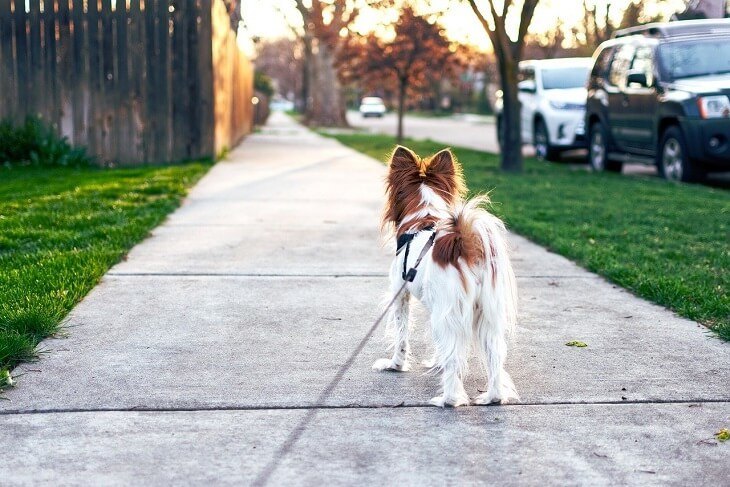Many dog owners will experience a dog that will refuse to move forward on a walk. This is especially common in puppies and adult dogs that are new to the home, as they may have never experienced walking on a leash before.
Most of the time a dog will refuse to walk because they are feeling anxious about something on the walk. However, feeling uncomfortable can sometimes also be the cause, and occasionally stubborn dogs will refuse to walk in an effort to get something they want.
Today I’m sharing 4 things dog owners can do to get their dogs to walk when on leash. To tackle this issue I will first be explaining what causes this problem and then how you can address it.
Let’s jump right into it.
What Causes Dogs to Stop Walking?
Before working to fix any issue you will first need to discover its cause. There are three vastly different potential causes for dogs refusing to walk on a leash.
Oftentimes this issue is caused by anxiety. However, stubbornness, pain, or being uncomfortable could also be the cause.
Let’s look into these reasons in greater detail.
Your Dog is Uncomfortable or in Pain
Dogs will sometimes refuse to walk if the action is painful or very uncomfortable for them. This issue can occasionally be as simple as their harness being too tight.
However, medical conditions or injuries could also potentially cause a dog to not enjoy walking.
This is an especially large concern for dogs who used to enjoy their daily walks and are now refusing to go.
This is fairly common in dogs as they age, as conditions that cause pain with movement such as arthritis are fairly common in elderly dogs.
Your Dog is Stressed or Anxious
Stress and anxiety is a fairly common problem for dogs that experience nervousness around strange stimuli, people, or dogs.
Does your dog seem excited to go for a walk and then stops in their tracks when they hear a car screeching its tires?
Or maybe everything is fine until one of your neighbor’s dogs starts barking at you from their backyard.
This type of an issue is more common in dogs than you may think.
Luckily, there are ways that you can help your nervous pup regain confidence and enjoy walkies again.
Your Dog Wants to go a Certain Way or Doesn’t Want to go Home
Some dogs will refuse to walk because they really want something. Maybe they want to go to the park instead of down the street.

If you walk to the park fairly often and your dog knows how to get there, this could be the cause. Dogs will sometimes do this when they see their house because they don’t want to go back inside as well.
Working on some more leash training will give you the tools that you need to redirect your dog in these types of situations. I’ll share how you can do just that in a bit!
4 Things to Do If Your Dog Doesn’t Want to Walk
There are four main things that you can do to remedy a dog that stops walking and won’t move.
It is important to note that these remedies will only work for a certain cause of this behavior.
For example, a dog refusing to walk due to pain will not likely get any benefit from further leash training.
Here is what you should do if a stubborn dog refuses to walk.
1. Change up Your Walking Gear
The first thing I always do as a dog trainer is take a quick look at the dog’s walking gear.
The collar or harness should be loose enough for you to fit a finger through (or a couple if you have small fingers).
However, it should also be tight enough for your dog not escape. You may need to get a martingale collar if you have a dog with a thin neck and head such as a Greyhound or Collie.
Similarly, some dogs do not feel comfortable in harnesses that have thin straps. This is because the material can cut into sensitive areas like a dog’s armpits or neck when pulled.
Changing your dog’s collar or harness to one that fits more comfortably can help. Here is an excellent harness with wider straps that is great for more sensitive dogs.
2. Visit the Vet
Sadly, refusing to walk may be a sign that your dog has an unseen injury or medical condition. This is especially true if your dog is suddenly refusing to walk when they didn’t used to.
Visiting your veterinarian can help you get to the root of the problem, or at least give you peace of mind and rule out a medical issue as the cause.
3. Make Walking a Fun Experience for Your Dog

You will likely need to do some desensitization training to make walks more fun for anxious dogs.
Here is a simple step by step process for how to give a dog more confidence when out on walks.
Step 1: Get some small training treats that your dog loves and choose a walking route that your dog seems to handle the best. (This will usually be an area your dog is familiar with such as your neighborhood.)
Step 2: Start your walk and give them a small training treat to start. When walking continuously check your dog’s body language. Does certain stimuli make your dog slightly nervous?
Whenever you notice any signs of slight tension (ears go back, lip licking, yawning, etc.) redirect your dog by calling their name and give them a treat.
Step 3: Continue giving your dog treats when they are showing signs of slight stress and slowly move up to things that they are more frightened of.
For things that stop your dog in their tracks, it is best to only approach from a distance that your dog is alright with and give them treats from there at first.
Step 4: Work on being able to get closer and closer to things on walks that make your dog anxious. It is best to do this slowly over time. A good pace for most dogs is to aim getting just one or two steps closer to that stimuli each day. It is important to try to not overwhelm your dog during this process.
Step 5: Continue this process until your dog is walking confidently around the block. If you have a particularly nervous dog, it is a good idea to continue having treats on hand. This way you can redirect your dog and boost their confidence in unexpected events such as loud noises.
4. Work on Some Leash Training
For stubborn dogs, you may want to work on some extra leash training. This will provide you with the necessary tools to get your dog back on track when out on a walk.
Some helpful commands to use in a situation like this are heel, focus, and recall.
You can do this by teaching your dog one of these commands in a low distraction environment such as in your home or backyard. This will teach your dog the cue so that you can use it later just like with any other basic obedience command.
Then, when your dog refuses to walk when on leash, prompt them with one of these commands. When they follow through it is important to mark the good behavior and reward it.
It may feel as if you are bribing your dog when giving them a treat after following these commands. However, it is important to remember that your dog is learning a new skill. The ultimate goal is to be able to ask for one of these commands when out on a walk and have your dog listen to you, even when you don’t have a treat.


